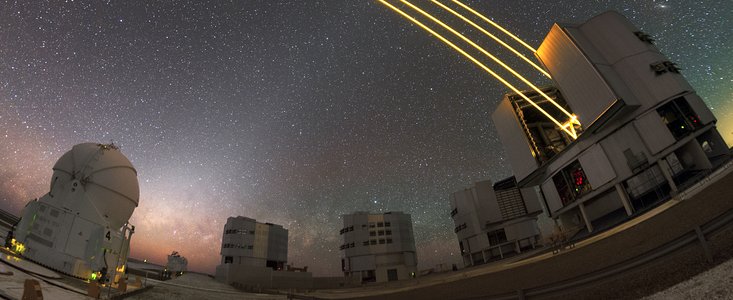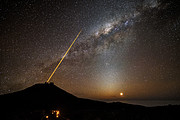Ogłoszenie
ESO’s Very Large Telescope Celebrates 20 Years of Remarkable Science
25 maja 2018
ESO’s Very Large Telescope, the flagship facility for European ground-based astronomy, celebrates its 20th anniversary today. The first of the VLT’s Unit Telescopes saw first light on 25 May 1998, ushering in a new era of astronomy. Over the following years three more 8.2-metre Unit Telescopes were completed and these giants were joined by the four smaller Auxiliary Telescopes (ATs) that form part of the VLT Interferometer. The interferometer first combined the light from two ATs in 2005, creating a virtual telescope up to 200 metres in diameter that now regularly observes the surfaces of stars.
The VLT could not function without its world-class suite of instruments, which have been developed in collaboration with astronomers and engineers in the ESO community. A spectacular recent addition to the VLT is the 4 Laser Guide Star Facility, which projects four 22-watt laser beams into the upper atmosphere to create artificial stars that help correct for the effects of atmospheric turbulence, a technique known as adaptive optics.
The instruments on the VLT are in high demand — last year the requested observing time exceeded the available time by a factor of five. Successful observing requests have provided the data behind thousands of peer-reviewed scientific papers — in 2017 alone, over 600 papers were published using data from the VLT.
ESO’s flagship observatory has not just led to a great quantity of science, but also quality. The VLT has contributed to breakthroughs in many areas of astronomy, and is responsible for seven of ESO’s Top 10 Astronomical Discoveries.
For instance, in 2009 the VLT overcame the demanding observational challenge of imaging a planet around another star for the first time, followed by the first analysis of the atmosphere around a super-Earth exoplanet in 2010. ESO has continued to build on this planet-hunting capability with SPHERE, a planet-hunting instrument that was added to the VLT in 2014.
Painstaking VLT observations spanning nearly two decades revealed the motions of stars orbiting the supermassive black hole at the centre of our galaxy. This continues to be a closely-studied topic — in fact, this week the VLT is scrutinising the star S2 as it passes close by this hidden monster. Just last year ESO’s fleet of telescopes, including the VLT, was used to observe another exotic phenomenon: the first light from a gravitational wave source.
On top of its scientific legacy, the VLT is also playing a vital role in preparing technology for ESO’s Extremely Large Telescope (ELT), currently under construction 23 kilometres from the VLT in the Atacama Desert in northern Chile. ESO’s experience in building and operating remote, cutting-edge observatories such as the VLT is proving vital in developing the ELT, the next frontier in ground-based astronomy.
Linki
Kontakt
Richard Hook
ESO Public Information Officer
Garching bei München, Germany
Tel: +49 89 3200 6655
Cell: +49 151 1537 3591
Email: pio@eso.org
O ogłoszeniu
| Identyfikator: | ann18035 |
Our use of Cookies
We use cookies that are essential for accessing our websites and using our services. We also use cookies to analyse, measure and improve our websites’ performance, to enable content sharing via social media and to display media content hosted on third-party platforms.
ESO Cookies Policy
The European Organisation for Astronomical Research in the Southern Hemisphere (ESO) is the pre-eminent intergovernmental science and technology organisation in astronomy. It carries out an ambitious programme focused on the design, construction and operation of powerful ground-based observing facilities for astronomy.
This Cookies Policy is intended to provide clarity by outlining the cookies used on the ESO public websites, their functions, the options you have for controlling them, and the ways you can contact us for additional details.
What are cookies?
Cookies are small pieces of data stored on your device by websites you visit. They serve various purposes, such as remembering login credentials and preferences and enhance your browsing experience.
Categories of cookies we use
Essential cookies (always active): These cookies are strictly necessary for the proper functioning of our website. Without these cookies, the website cannot operate correctly, and certain services, such as logging in or accessing secure areas, may not be available; because they are essential for the website’s operation, they cannot be disabled.
Functional Cookies: These cookies enhance your browsing experience by enabling additional features and personalization, such as remembering your preferences and settings. While not strictly necessary for the website to function, they improve usability and convenience; these cookies are only placed if you provide your consent.
Analytics cookies: These cookies collect information about how visitors interact with our website, such as which pages are visited most often and how users navigate the site. This data helps us improve website performance, optimize content, and enhance the user experience; these cookies are only placed if you provide your consent. We use the following analytics cookies.
Matomo Cookies:
This website uses Matomo (formerly Piwik), an open source software which enables the statistical analysis of website visits. Matomo uses cookies (text files) which are saved on your computer and which allow us to analyze how you use our website. The website user information generated by the cookies will only be saved on the servers of our IT Department. We use this information to analyze www.eso.org visits and to prepare reports on website activities. These data will not be disclosed to third parties.
On behalf of ESO, Matomo will use this information for the purpose of evaluating your use of the website, compiling reports on website activity and providing other services relating to website activity and internet usage.
Matomo cookies settings:
Additional Third-party cookies on ESO websites: some of our pages display content from external providers, e.g. YouTube.
Such third-party services are outside of ESO control and may, at any time, change their terms of service, use of cookies, etc.
YouTube: Some videos on the ESO website are embedded from ESO’s official YouTube channel. We have enabled YouTube’s privacy-enhanced mode, meaning that no cookies are set unless the user actively clicks on the video to play it. Additionally, in this mode, YouTube does not store any personally identifiable cookie data for embedded video playbacks. For more details, please refer to YouTube’s embedding videos information page.
Cookies can also be classified based on the following elements.
Regarding the domain, there are:
- First-party cookies, set by the website you are currently visiting. They are stored by the same domain that you are browsing and are used to enhance your experience on that site;
- Third-party cookies, set by a domain other than the one you are currently visiting.
As for their duration, cookies can be:
- Browser-session cookies, which are deleted when the user closes the browser;
- Stored cookies, which stay on the user's device for a predetermined period of time.
How to manage cookies
Cookie settings: You can modify your cookie choices for the ESO webpages at any time by clicking on the link Cookie settings at the bottom of any page.
In your browser: If you wish to delete cookies or instruct your browser to delete or block cookies by default, please visit the help pages of your browser:
Please be aware that if you delete or decline cookies, certain functionalities of our website may be not be available and your browsing experience may be affected.
You can set most browsers to prevent any cookies being placed on your device, but you may then have to manually adjust some preferences every time you visit a site/page. And some services and functionalities may not work properly at all (e.g. profile logging-in, shop check out).
Updates to the ESO Cookies Policy
The ESO Cookies Policy may be subject to future updates, which will be made available on this page.
Additional information
For any queries related to cookies, please contact: pdprATesoDOTorg.
As ESO public webpages are managed by our Department of Communication, your questions will be dealt with the support of the said Department.



